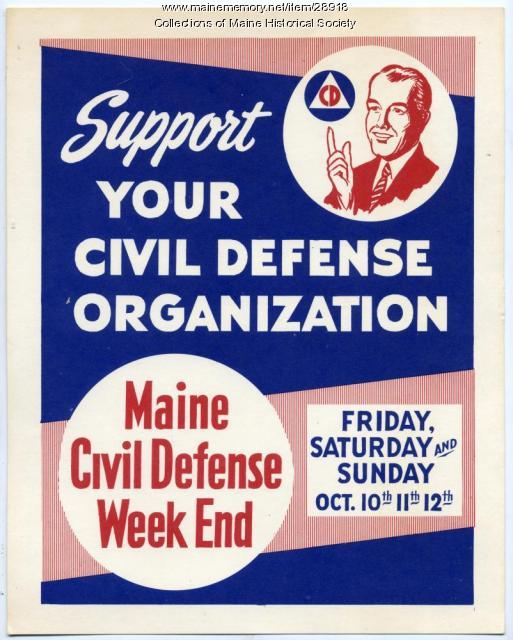Keywords: Family relations
- Historical Items (178)
- Tax Records (0)
- Architecture & Landscape (0)
- Online Exhibits (77)
- Site Pages (117)
- My Maine Stories (43)
- Lesson Plans (1)
Online Exhibits
Your results include these online exhibits. You also can view all of the site's exhibits, view a timeline of selected events in Maine History, and learn how to create your own exhibit. See featured exhibits or create your own exhibit
Exhibit
Northern Threads: Outerwear, Militia & Cadet uniforms
A themed vignette within "Northern Threads Part I," featuring 19th century outerwear, bonnets, militia and cadet uniforms.
Exhibit
Home Ties: Sebago During the Civil War
Letters to and from Sebago soldiers who served in the Civil War show concern on both sides about farms and other issues at home as well as concern from the home front about soldiers' well-being.
Exhibit
Fallen Heroes: Those Who Gave Their Lives: World War II
At least twenty-three Jewish men from Maine died in the military during World War II. Photographs and other memorabilia are available for fewer than half of them. Read more about them.
Exhibit
Immigration is one of the most debated topics in Maine. Controversy aside, immigration is also America's oldest tradition, and along with religious tolerance, what our nation was built upon. Since the first people--the Wabanaki--permitted Europeans to settle in the land now known as Maine, we have been a state of immigrants.
Exhibit
When Europeans arrived in North America and disrupted traditional Native American patterns of life, they also offered other opportunities: trade goods for furs. The fur trade had mixed results for the Wabanaki.
Exhibit
Monuments to Civil War Soldiers
Maine supplied a huge number of soldiers to the Union Army during the Civil War -- some 70,000 -- and responded after the war by building monuments to soldiers who had served and soldiers who had died in the epic American struggle.
Exhibit
Anglo-Americans in northern New England sometimes interpreted their own anxieties about the Wilderness, their faith, and their conflicts with Native Americans as signs that the Devil and his handmaidens, witches, were active in their midst.
Exhibit
Mural mystery in Westport Island's Cornelius Tarbox, Jr. House
The Cornelius Tarbox, Jr. House, a well-preserved Greek Revival house on Westport Island, has a mystery contained within--a panoramic narrative mural. The floor-to-ceiling mural contains eight painted panels that create a colorful coastal seascape which extends through the front hallway and up the stairwell. The name of the itinerant painter has been lost over time, can you help us solve the mystery of who he or she was?
Exhibit
Most societies have had rituals or times set aside to honor ancestors, those who have died and have paved the way for the living. Memorial Day, the last Monday in May, is the day Americans have set aside for such remembrances.
Exhibit
John Dunn, 19th Century Sportsman
John Warner Grigg Dunn was an accomplished amateur photographer, hunter, fisherman and lover of nature. On his trips to Ragged Lake and environs, he became an early innovator among amateur wildlife photographers. His photography left us with a unique record of the Moosehead Lake region in the late nineteenth century.
Exhibit
San Life: the Western Maine Sanatorium, 1928-1929
Merle Wadleigh of Portland, who was in his mid 20s, took and saved photographs that provide a glimpse into the life of a tuberculosis patient at the Western Maine Sanatorium in Hebron in 1928-1929.
Exhibit
Civil Defense: Fear and Safety
In the 1950s and the 1960s, Maine's Civil Defense effort focused on preparedness for hurricanes, floods and other natural disasters and a more global concern, nuclear war. Civil Defense materials urged awareness, along with measures like storing food and other staple items and preparing underground or other shelters.
Exhibit
Music in Maine - Community Music
"Kemp Family Singers Kemp Family Singers broadside, Leeds, ca. 1895Maine Historical Society George Washington Kemp, Leeds, ca."
Exhibit
St-Jean-Baptiste Day -- June 24th -- in Lewiston-Auburn was a very public display of ethnic pride for nearly a century. Since about 1830, French Canadians had used St. John the Baptist's birthdate as a demonstration of French-Canadian nationalism.
Exhibit
From the last decades of the nineteenth century through about the 1920s, vacationers were attracted to large resort hotels that promised a break from the noise, crowds, and pressures of an ever-urbanizing country.
Exhibit
Photojournalism & the 1936 Flood
Photojournalism & the 1936 Flood examines the monumental destruction caused by the historic flood of 1936 through the comprehensive and innovative photojournalism done by the Guy Gannett Publishing Company in the weeks surrounding the flood.
Exhibit
Maine Through the Eyes of George W. French
George French, a native of Kezar Falls and graduate of Bates College, worked at several jobs before turning to photography as his career. He served for many years as photographer for the Maine Development Commission, taking pictures intended to promote both development and tourism.
Exhibit
History in Motion: The Era of the Electric Railways
Street railways, whether horse-drawn or electric, required the building of trestles and tracks. The new form of transportation aided industry, workers, vacationers, and other travelers.
Exhibit
Selections from the Collections
Maine Historical Society staff come across unique and unforgettable items in our collections every day. While it's difficult to choose favorites from a dynamic collection, this exhibit features memorable highlights as selected by members of the MHS staff.
Exhibit
These stories -- that stretch from 1999 back to 1759 -- take you from an amusement park to the halls of Congress. There are inventors, artists, showmen, a railway agent, a man whose civic endeavors helped shape Portland, a man devoted to the pursuit of peace and one known for his military exploits, Maine's first novelist, a woman who recorded everyday life in detail, and an Indian who survived a British attack.
Exhibit
"We are growing to be somewhat cosmopolitan..." Waterville, 1911
Between 1870 and 1911, Waterville more than doubled in size, becoming a center of manufacturing, transportation, and the retail trade and offering a variety of entertainments for its residents.
Exhibit
George F. Shepley: Lawyer, Soldier, Administrator
George F. Shepley of Portland had achieved renown as a lawyer and as U.S. Attorney for Maine when, at age 42 he formed the 12th Maine Infantry and went off to war. Shepley became military governor of Louisiana early in 1862 and remained in the military for the duration of the war.
Exhibit
For the Union: Civil War Deaths
More than 9,000 Maine soldiers and sailors died during the Civil War while serving with Union forces. This exhibit tells the stories of a few of those men.
Exhibit
Rumford's Notable Citizens in the Civil War
A number of Rumford area residents played important roles during the Civil War -- and in the community afterwards. Among these are William King Kimball, who commanded the 12th Maine for much of the war.
























